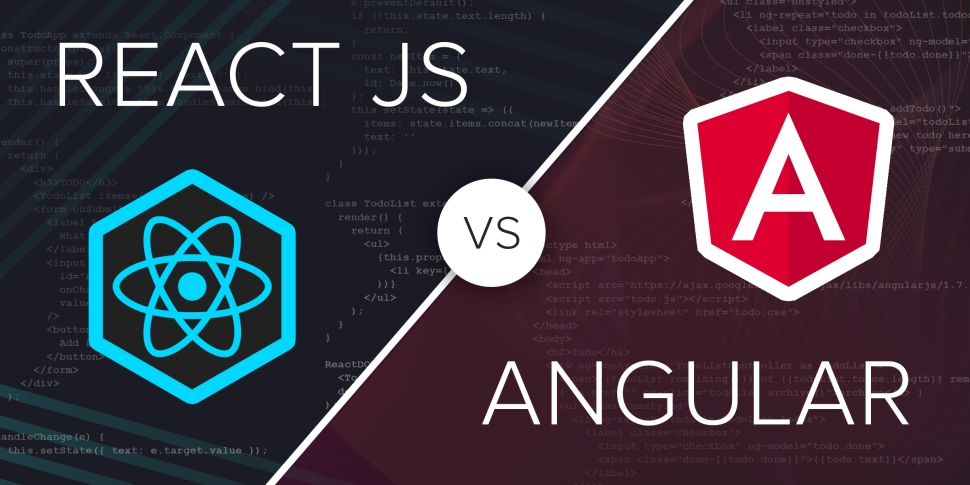The difference between Angular Vs React is that Angular is a JavaScript framework created using TypeScript. In contrast, React.js is a JavaScript library designed using JSX.
Angular is used for enterprise-grade applications like progressive apps or single-page apps. On the other hand, React is used to design UI components in applications with frequently variable data.
Moving on, there’s an importance of a learning curve when it comes to using programming languages. In Angular, the learning curve is steep due to too many built-in functionalities. In React, the learning curve is shallow due to the smaller package size.
Are There Major Differences Between Angular Vs React?
As front-end development frameworks, Angular Vs React have multiple differences. Like, two-way data binding is used by Angular, while React just uses one-way data binding.
The biggest difference between them is that React is just a JavaScript Library, while Angular comprises of an actual, comprehensive framework.
This difference of “Framework vs. Library” is what a front end developer needs to understand when it’s trying to differentiate between Angular vs React.
If you are using React, you can leverage additional programming libraries within it, however, you can’t do that for Angular, since it doesn’t require you to do so, offering a complete framework solution for front-end development.
React, and Angular are arguably part of the “Big 5” of JavaScript frameworks for front-end development that is available in the market. As such, we felt that following our piece on React Native vs Flutter Apps vs Xamarin; we should focus on the differences between Angular and React.
Angular Vs React – A Brief History And Definition.

What is ReactJS?
React can be best described as a JavaScript Library that can be utilized if you want to build or create user interfaces that are highly interactive and versatile. Through React, each state in your app can acquire simple views by allowing you to design them.
Using React will help you when your data state changes and the framework will easily update all the required components and render them in the right place. This makes the building of interactive UIs are a breeze for anyone.
ReactJS is an open-source JavaScript library used for front-end development and the building of dynamic user interfaces. React is also used in the creating of SPAs and mobile applications.
It was initially introduced by a Software Engineer at Facebook on September 26, 2017, with its early prototype being called “FaxJS.”
Although, when it comes to mobile app development, React is only useful for rendering data to DOM, which means that in order to create an app using React, you need to leverage additional libraries for routing and state management. Examples of such libraries are Redux and React Router.
Based primarily on JavaScript and JSX (a PHP extension), its creation was heavily influenced by XHP, which is a component library for PHP allowing XML Syntax for the development of custom and reusable HTML elements.
React is also a popular choice for building reusable HTML elements for front-end development as well.
What Is AngularJS?
On the other end of the spectrum, Angular is a one-stop framework model to build desktop and mobile applications.
Once you master it, you can repurpose your code to any platform you intend to and get your apps built in a faster, more agile manner. Its Web Workers and server-side rendering features allow you to build apps that can work incredibly fast on desktop platforms.
Angular allows you to leverage incredible scalability while using it and even huge data sets can leverage on it.
Google’s largest applications are built on Angular so you can understand just how incredibly scalable it is and how advanced its infrastructure is.
It has existing templates, it allows you to use existing components as well as bring them in on your own, so you have zero difficulties in building the features you want in your app.
Angular allows you to create amazing apps with incredible support, infrastructure, scalability, and data handling capabilities. It has tools and support components for almost anything a front-end developer might need to build for an app to function incredibly well and look flawless.
Angular is a TypeScript-based open-source front-end development framework developed by Google. Angular is part of the MEAN stack, making it compatible with numerous code editors as well as all programs written in JavaScript. Angular is used today for the development of dynamic websites and web apps.
Angular’s most recent version was released on February 7, 2020, called Angular 9. Though Google still supports AngularJS, it’s the first version. Angular 9 moves all apps to use Ivy compiler and runtime as default. Moreover, Angular 9 has been updated to work with TypeScript 3.6 and 3.7. What’s new about Angular 9? Let’s take a look.
- Even Faster Testing
- Smaller bundle sizes
- Improved debugging
- Improved build errors
- Improved CSS class
- Improved style binding
- Optimized type checking
The two front-end development frameworks are used by various reputed brands, including:
(Brands That Use React vs. Angular)
With that basic understanding of what these platforms are and their history, let’s dive deeper into the debate of Angular JS vs React JS. Let’s take a look at the benefits of using React or Angular, the things you should consider before choosing Angular or React, and how to decide if your team is ready to leverage them or not.
What are the Benefits of ReactJS?
A Better User Experience
React leverages Virtual Document Object Model(VDOM), which is a virtual representation of the UI that is stored in memory to be synced with the Real DOM by a React library such as ReactDOM.
This allows React app developers to make updates and changes to an application without affecting other parts of the interface much more easily while maintaining a highly dynamic User Interface with swift user experience.
Code Reusability Saves Time
React app development companies have the distinct advantage of code components reusability in multiple ways at any point in time during react app development.
These components are isolated and independent from one another, allowing developers to change or update them without affecting any other component, saving ample time during the management of updates, making react app development much more timesaving and efficient.
Hot Reloading Empowers Quick Development
One of the best advantages of React is that developers can reuse existing code and apply hot reloading within the app development process. To those who don’t know what hot reloading is, Hot Reloading is keeping an app running while injecting new versions of an edited file at runtime.
This ensures that developers can hold on to their state if they’re making adjustments to the User Interface. React allows this possibility, helping improve the performance of an app but also to speed up the app development process.
One-Directional Data Binding For Stable Coding.
One of the advantages of using React is that developers can work directly with components and leverage downward data binding. This ensures that within those components, the parent entities are not affected or changed due to changes to their child entities.
This is because components are individually handled in React, making your code much more stable and allowing future development much more convenient and easy for react developers.
What Are The Benefits Of Using Angular as a Front-End Development Framework?
Angular is TypeScript-based, which makes it a superset of JavaScript. With Angular, you have the ability to compile JavaScript and make the process of eliminating coding errors much quicker while typing.
This makes Angular an excellent choice for cleaner, errorless, and high-quality app development. For App development companies, Angular is a great investment if they’re looking to get into Enterprise app development.
Higher Performance With Pre-Built Material Design Components
Angular is built on a hierarchical dependency injection, which makes it different and much better from its predecessor AngularJS. In AngularJS, classes are not dependent on each other and require external sources, which assists in delivering higher performance to Angular mobile applications.
With Angular, mobile app developers gain access to pre-built material design components for navigation elements, form controls, pop-ups, layouts, and data tables.
This allows high usability and performance of Angular based products and ensures that they are long-lasting for users.
Angular CLI allows for easy Updates
Angular CLI (Command Line Interface) allows developers with top of the line testing tools and simpler commands, which is especially good for new adopters. Angular is also widely supported by community members, engineers, and platforms, making it easier to updates, even for components that have third-party dependencies.
10 Factors to Consider in Choosing between React vs Angular For App Development
If you’ve searched for Angular vs React, then I’m sure you’re looking for more than just their benefits. This section of the article deals with the 10 factors that you need to look at when choosing to React vs Angular for your App development team or application development project. These 10 factors are:
- Popularity
- Architecture
- Learning Curve
- Development Speed
- Flexibility
- DOM
- Data Binding
- Mobile Solutions
- Testing
- Community Support
1. Popularity
According to insights from Stackoverflow’s survey, in 2019, React was more popular in terms of usage, though still significantly overshadowed by jQuery.
Nevertheless, within the Angular/AngularJS vs React JS debate, in terms of popularity, React was the preferred choice amongst web frameworks and libraries in 2019, which was a switch from the trends in 2018.
So, the popular vote goes to React.
2. Architecture
In terms of the architecture, while both Angular and React have a component-based architecture, their modular components are similarly reusable and robust. The difference between Angular and JS in terms of the architecture is within the language they utilize.
React uses JavaScript, the most popular language, according to StackOverflow’s survey, while Angular makes use of Typescript for web development. While Typescript is considered to be a lot more robust and errorless, most app development companies use JavaScript within their process.
So the decision here is based on the skillset of your app development team and their readiness to learn a new skillset, when choosing between Angular and React.
3. Learning Curve
Angular is harder to master when compared to React, with a steep learning curve. The Angular framework is dynamic and has multiple solutions to solving problems while maintaining a complex management system for its components. Furthermore, to leverage Angular, developers must familiarize themselves with templates, pipes, and dependency injections. Adding on to that, developers also have to be familiar with RxJS and Typescript in order to ensure high-quality production using Angular.
The Angular framework is always developing, with Angular 9 now released, burdening developers to always be on the lookout for the most recent changes and upgrades to the ecosystem and evolve their skillset with that.
On the other hand, ReactJS is much easier to learn. For developers with a thorough understanding of JavaScript, making an app with React is much easier. ReactJS provides developers with resources that can be used for multiple purposes within the ecosystem.
This is especially beneficial for newcomers who are understanding the framework and looking to develop their first app using react.
In terms of the learning curve, React takes our vote in comparison to Angular.
4. Development Speed and Productivity
We’ve already talked a bit about Angular’s Command Line Interface. As a result of its CLI, Angular allows the swift designing of applications and the production of components and services with one-line commands. This is possible as a result of its built-in process for error adjustments, clean coding, and its use of Typescript.
With React, the speed of development is often negatively impacted due to the involvement of third-party libraries. React developers have to go through the process of determining the right architecture and the tools they need for the project. This toolkit keeps varying for React app development from project to project.
These forces react developers to spend more time and effort for developers involved in mid-development or for updates to the app.
So in terms of development speed, Angular takes our vote.
5. Flexibility and Freedom
Flexibility is an important contributor to the React vs Angular question. If you’re a developer that enjoys freedom and customization, then the React framework is the best choice for you. React allows developers to choose their own tools, libraries, and development architecture for their app development projects.
This makes it possible to build highly-customized apps based on the technology stack and features of your choice and requirement. For ReactJS development teams or ReactJS developers, this is a great benefit they have over Angular.
Meanwhile, Angular only allows developers a limited set of Angular components inside frameworks. This limits the amount of freedom with which Angular developers can operate, making their apps less customizable.
The vote on this comparison easily goes to React.
6. DOM (Document Object Model)
The Difference between Angular and ReactJS between their use of DOM and VDOM is worth immense consideration.Angular’s use of DOM means that even if one section of the DOM is altered, the whole tree data structure is updated.
On the other hand, React’s use of Virtual DOMSin Reactjs app development allows app development companies to easily track and update changes to the VDOM without affecting any other section of the tree data structure. Moreover, Virtual DOM is also vastly considered much faster in performance than real DOM, which makes it much better for app development.
Based on these factors, our vote based on the use of DOM and VDOM goes to React.
7. Data Binding
Data binding plays an important role in the decision to choose frameworks to React and Angular. React is based on one-way data binding while Angular works with two-way data binding. With One-way binding, within React development, changes to the UI elements can only be made after altering the model state. The developers are unable to make changes to the UI without updating the corresponding model state first.
Within Angular mobile app development, two-way binding is used. This allows the developers to make changes to UI elements or the model state, and the corresponding change to the other is made automatically. This is easier to do, much more effective, and faster.
On the other hand, there’s a disadvantage to two-way data binding with regards to large apps and enterprise development. One-way binding with React allows for a much better data overview, that’s more streamlined.
So, depending on the project, both these options can be incredibly useful with their own unique benefits.
8. Mobile Solutions
Angular’s comes with certain limitations with regards to its app development solutions. It offers the Ionic framework for mobile app development, alongside the Cordova container and a UI component library. While all that sounds good, when you develop an application with it and view it on a device, in appearance, it looks like a website inside a native web app container. From a UI/UX perspective, this is not good enough, especially considering that this is not a problem React faces.
React’s JavaScript library offers a native UI experience that allows developers to make their own components and bind them with native codes. Be it in Kotlin or Objective C, but more on that in our article on Java vs Kotlin.
Based on this analysis, our trust with regards to mobile solution goes to React.
9. Testing
In terms of bug testing, Angular provides developers with the possibility of using one tool for the entire project’s testing. This includes tools such as Jasmine and Protractor, which are considered industry-standard by many professionals. On the other hand, React requires the use of different tools for different kinds of tests within Reactjs app development.
Developers have to use different tools for Render testing, Code Testing, component testing, and unit testing. This increases the overall timeline of the app development process and also requires more effort on the developer’s end.
Hence, although it goes without saying, the winner of this Angular vs React debate is Angular.
10. Community Support
Lastly, we are ye to talk about community support. React offers a wider support community on GitHub and GitLab and an improvement from 2018, React is also now also more widely used that Angular, according to Stackoverflow’s report, we highlighted earlier.
So while both these front-end development frameworks have immense support from the developer community, React does edge ahead of Angular within these criteria.
How To Decide If React JS App Development Is The Right Choice For You

It’s one thing to know the benefits of using React; it’s completely another thing to understand if your team is ready to take on React App development. These are the four things you need to look out for in your team before you get on with using React:
- Your team understands how to use HTML, CSS, and JavaScript.
- The project you’re undertaking requires a highly customized app solution.
- The development process requires a lot of different features and variable states in the development process.
- The project requires the sharing of different components to be shared across a number of applications.
How To Decide If Angular App Development Is The Right Choice For You
As it is the case with React, these four things are necessary for you to know before you take on Angular app development.
- It’s crucial for your team to have expertise and experience using C#, Java, and the previous versions of Angular.
- Angular is best suited for low-medium complexity apps.
- You embrace ready-to-use solutions and need higher productivity.
- If your team needs to use Bundle Budgets via the CLI option, then Angular is the way to go. It allows Developers to limit the app size to pre-decided values.
Disadvantages of React
Like with every other framework, Reach also has some disadvantages, and here they are:
- Sophisticated configuration is required when you’re opting for integrating Reacts in the traditional MVC framework.
- ReactJS requires the developers or general audience to have in-depth knowledge concerning UI integration to the MVC framework.
Disadvantages of Angular
Angular too has its disadvantages, and the upcoming list of cons is a little longer as compared to React’s list:
- Sophisticated features can be confusing for fresh developers.
- The learning curve is steep.
- Super-complex third-party integration.
- The speed of Angular slows down with pages embedding interactive elements.
- Limited routing.
- You’ll face several issues while upgrading from an older version of Angular to a newer one.
- There are no clear directions, manual, or documentation for the Angular framework.
When to Choose to React?
React native is certainly the best framework that you can use to create a platform-specific version of components. This platform-specific version creation enables the developers to create a single codebase shared across multiple platforms.
Therefore, it is implied that leveraging React framework for your projects means that you’re ensuring efficiency, quality, and robustness in the long term.
From creating sophisticated native apps based on Android or iOS to leveraging the best-in-class JavaScript library building and integrating robust user interfaces within apps, React can be used for a variety of purposes.
Ideally, here are a few points that indicate that you should use React framework for your project:
- Your app has multiple events.
- Your application development team is experienced in using HTML, CSS, and JavaScript.
- The app is intended to be a custom-tailored solution.
- The app has sharable components.
When To Choose Angular?
Angular is more inclined towards the dynamic side of the project development. The core reason for the popularity of Angular is that it enables the developers or users to ensure secure data binding to HTML elements.
Additionally, Angular directives explored a way to build HTML and CSS modular components, which was another reason for the popularity of this framework.
From building interactive and intriguing experiences to integrating compelling features to the digital project, i.e., two-way binding, modularization, dependency injection, and even AJAX handling.
Furthermore, Angular can be used in case the project demands the following aspects:
- You want to ensure higher productivity.
- You’re looking for a ready-to-use solution for your project.
- Your objective is to build a feature-packed application.
- If your team has command over Java, C#, or previous versions of Angular.
Which One Is Better Out Of The Two?
React is better than Angular from a technical standpoint because it has more modern features like Virtual DOM implementation and rendering optimizations. React also offers numerous solutions to developers that they can use.
Furthermore, migrating between React’s versions is super-convenient as compared to migration between other frameworks. This also means that you don’t have to install updates one by one.
However, the final verdict would be that both React and AngularJS have their features, functionalities, specifications, and more. They have their specific use, and they’re great when creating a single-page application.
The main difference between the two frameworks comes in the form of instruments.
Over the internet, you’ll find several opinions of experienced professionals that React is better than Angular or vice versa, but in reality, it depends on your specific requirements.
Both the frameworks are more than capable of handling sophisticated projects. However, the best practice would be to make your choice depending on your project’s requirements, features, and usability.
React vs Angular Developer Demand in the Market
The employment market in 2025 still exhibits high demand for both Angular and React developers, although the nature of the jobs and industries prefers different strengths of each framework. React is still a leading force in startups, SaaS platforms, and businesses adopting Jamstack or serverless architectures.
Conversely, Angular remains to be a star in enterprise, government, and industries such as healthcare and finance where stability, maintainability, and long-term support are necessary.
With Angular 17’s improvements—improved performance, standalone components, and improved tooling—companies are investing in large-scale apps that require consistency and well-established architecture.
In the end, React and Angular have both established separate niches in the employment marketplace. React provides more general versatility and more immediate entry points for programmers, whereas Angular holds high demand for intricate, enterprise-scale applications.
Conclusion
In terms of the benefit analysis, It’s clear that the Angular vs React Js war is heavily won by React JS. It more popular, easier to learn, much more flexible and customizable, and provides great community support, which is crucial for new adopters of React.
Though the future of both React and Angular looks bright. React, and Angular is not going anywhere for some time, and for developers who are looking to specialize in React app development or Angular app development, both of them are good options, although, in terms of development benefits, the final word goes in favor of React.
Also, to learn about the type of apps and the best-fit languages for these different apps, read our blog on “How Many Types Of Apps Are There.”
- Need help creating an engaging app?
- We’re the partners you’re looking for! We help businesses build apps that convert and meet their business goals. From prototypes to post development support and maintenance, we’ve got experts to make sure your app’s the next big thing.
-
 Strategy
Strategy Design
Design Development
Development

 5571 Views
5571 Views July 2, 2025
July 2, 2025









